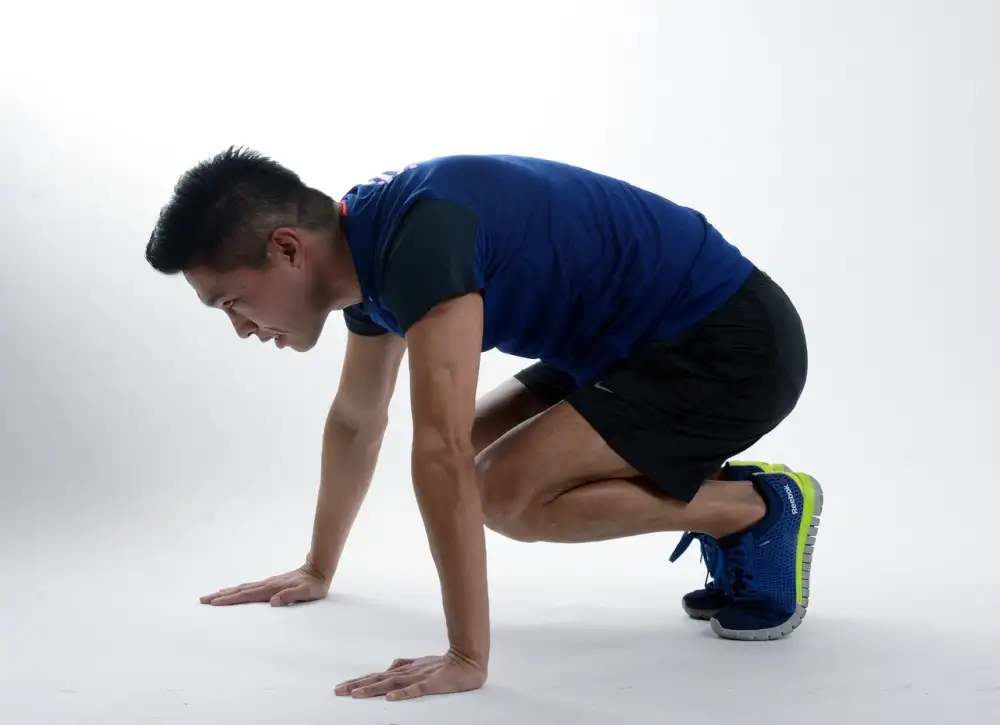Burpee Pull Ups: The Ultimate Full-Body Challenge

Muscles Worked
The burpee pull-up is a full-body exercise that targets multiple muscle groups simultaneously. This dynamic movement engages muscles in the upper body, lower body, and core, making it a highly effective compound exercise.
Let's break down the muscles worked during a burpee pull-up:
Upper Body:
Back: Your latissimus dorsi (lats), trapezius (traps), and rhomboids are heavily engaged during the pull-up portion of the exercise. These muscles are responsible for pulling your body up towards the bar.
Chest: Your pectoral muscles (pecs) are activated as you push yourself up from the burpee position and assist in the upward movement of the pull-up.
Shoulders: Your deltoids (shoulder muscles) work to stabilize your shoulders during both the burpee and pull-up phases.
Arms: Your biceps and triceps are heavily involved in both the pushing and pulling movements of the exercise. Your biceps help you pull yourself up during the pull-up, while your triceps assist in pushing yourself up from the burpee.
Lower Body:
Quadriceps: Your quads are the primary muscles used to power you up from the squat position of the burpee.
Hamstrings: Your hamstrings work in conjunction with your quads to propel you upward and control your descent.
Glutes: Your glutes (buttocks muscles) are engaged during the squat and jump portions of the burpee, providing power and stability.
Core:
Abdominals: Your rectus abdominis (abs), obliques, and transverse abdominis are all heavily engaged throughout the entire exercise to stabilize your body and maintain proper form.
In summary, the burpee pull-up is a challenging yet rewarding exercise that effectively targets multiple muscle groups throughout your entire body. By incorporating this exercise into your workout routine, you can enhance your strength, power, and muscular endurance.
Burpee Pull Up Benefits
The burpee pull-up is not for the faint of heart. This challenging exercise combines two bodyweight powerhouses – the burpee and the pull-up – into one dynamic movement. But the rewards are well worth the effort. Let’s break down the benefits:
Full Body Strength and Conditioning: This exercise targets multiple muscle groups simultaneously. You are engaging your legs, core, chest, back, shoulders, and arms. This full-body engagement leads to significant strength gains and improved muscular endurance.
Cardiovascular Powerhouse: The explosive nature of burpees, coupled with the upper body challenge of pull-ups, sends your heart rate soaring. This makes it an incredibly effective cardiovascular workout, improving your heart health and calorie expenditure.
Improved Coordination and Body Awareness: Coordinating the transition between a burpee and a pull-up requires significant body control and coordination. Regular practice enhances your proprioception – your body’s awareness of its position in space.

Increased Power and Explosiveness: The burpee pull-up is a plyometric exercise, meaning it involves rapid stretching and contracting of muscles. This type of training develops your fast-twitch muscle fibers, leading to increased power and explosiveness in your movements.
Time-Efficient Workout: Short on time? The burpee pull-up is your answer. Its high-intensity nature allows you to pack a full-body workout into a shorter time frame, making it ideal for busy individuals.
Mental Toughness Builder: Let’s face it, burpee pull-ups are tough. Pushing through the fatigue and completing each rep builds mental resilience and a ‘can-do’ attitude that translates to other areas of life.
Progression and Variations: The beauty of the burpee pull-up lies in its versatility. You can modify it to match your fitness level. Beginners can start with fewer reps or modify the pull-up portion. As you get stronger, you can increase reps, add weight, or explore advanced variations.
Incorporating burpee pull-ups into your fitness routine is a surefire way to elevate your fitness levels. Remember to start slow, focus on proper form, and listen to your body. With consistency and dedication, you’ll reap the remarkable benefits of this challenging yet rewarding exercise.
Burpee Pull Up Variations
The burpee pull-up is a challenging full-body exercise that combines the classic burpee with a pull-up. This exercise is a great way to build strength, power, and endurance.
To perform a standard burpee pull-up, start by standing with your feet shoulder-width apart and your arms at your sides. Squat down and place your hands on the floor in front of you, shoulder-width apart. Kick your feet back into a push-up position. Do one push-up. Then, quickly jump your feet back to your hands. Stand up and immediately jump up and grab onto a pull-up bar with an overhand grip, slightly wider than shoulder-width apart. Pull yourself up until your chin is over the bar. Lower yourself back down until your arms are fully extended. This is one repetition.
There are many variations of the burpee pull-up that you can try. Some popular variations include:
Burpee chin-up: This variation is the same as the burpee pull-up, but instead of using an overhand grip, you use an underhand grip.
Burpee jumping pull-up: To make the exercise more challenging, you can add a jump to your pull-up. To do this, explosively pull yourself up so that your chest touches the bar.
Burpee muscle-up: This advanced variation combines the burpee pull-up with a muscle-up. To do a muscle-up, you will need to pull yourself up and over the bar so that your chest is at the top of the bar.
Burpee weighted pull-up: You can also add weight to your burpee pull-ups by wearing a weight vest or by attaching weights to a weight belt.

Burpee band-assisted pull-up: If you are not yet able to do a full pull-up, you can use a resistance band to assist you.
No matter what variation you choose, burpee pull-ups are a challenging and effective exercise that can help you reach your fitness goals.
Here are some tips for performing burpee pull-ups:
Use proper form. Proper form is essential to avoid injury. Make sure to keep your core engaged and your back straight throughout the exercise.
Start with a few repetitions. If you are new to burpee pull-ups, start with a few repetitions and gradually increase the number of repetitions as you get stronger.
Listen to your body. If you start to feel any pain, stop and rest.
Burpee pull-ups are a challenging exercise, but they are also very rewarding. By adding this exercise to your workout routine, you can build strength, power, and endurance.
How to do it
Begin with a strong starting position. Stand with your feet shoulder-width apart and your arms at your sides. Squat down and place your hands on the floor in front of you, just outside of your feet. Kick your feet back into a plank position, making sure your body is in a straight line from your head to your heels. Do a push-up, lowering your chest to the floor. Push back up to the plank position. Jump your feet forward to your hands. Explosively stand up and jump vertically in the air. As you land, immediately grab onto a pull-up bar with an overhand grip, slightly wider than shoulder-width apart. Hang from the bar with your arms fully extended. Pull yourself up until your chin is over the bar. Lower yourself back down to the starting position with a controlled motion.
If you're new to burpee pull-ups, start with a smaller number of repetitions and gradually increase the number as you get stronger. You can also modify the exercise by doing the pull-ups on an assisted pull-up machine or by using resistance bands. Listen to your body and take breaks when needed. If you experience any pain, stop the exercise and consult with a healthcare professional.
Common Mistakes
Many people make mistakes when performing burpee pull-ups, which can lead to injuries and reduced effectiveness. Here are some common mistakes to avoid:
Rushing the movement. One of the biggest mistakes people make is rushing through the burpee pull-up. This can cause you to use improper form and increase your risk of injury. Instead, focus on performing each part of the exercise with control and precision.
Not engaging your core. Engaging your core helps to stabilize your body and prevent injury. Make sure to keep your core muscles engaged throughout the entire exercise.
Arching your back. Another common mistake is arching your back, which can put stress on your spine. Keep your back straight throughout the exercise, even when you are in the plank position.


Using momentum instead of muscle. Some people use momentum to swing themselves up to the pull-up bar. This takes the emphasis off of the muscles you are trying to work. Instead, use a slow and controlled motion to pull yourself up.
Not using a full range of motion. Not using a full range of motion will reduce the effectiveness of the exercise. Make sure to lower yourself all the way down to the ground in the burpee and fully extend your arms at the bottom of the pull-up.
Overtraining. Burpee pull-ups are a challenging exercise, so it is important to listen to your body and not overdo it. If you are new to this exercise, start with a few repetitions and gradually increase the number as you get stronger.
By avoiding these common mistakes, you can make sure you are getting the most out of your burpee pull-ups and reducing your risk of injury. Remember to focus on quality over quantity, and always listen to your body. If you experience any pain, stop exercising immediately.
Burpee pull-ups: the only love-hate relationship your muscles actually need.
Elara Nightshade
Safety Tips
Before attempting burpee pull-ups, it's crucial to prioritize safety to prevent injuries.
Warm-up: Never jump into burpee pull-ups without a proper warm-up. This exercise engages multiple muscle groups, so dedicate at least 10 minutes to dynamic stretches like arm circles, leg swings, and torso twists. This prepares your muscles and joints for the intense workout ahead.
Proper Form: Maintaining correct form throughout the exercise is paramount. During the burpee, engage your core to protect your lower back. When transitioning to the pull-up, avoid swinging or using momentum. Focus on controlled, deliberate movements. If you find yourself compromising form due to fatigue, stop and rest.
Gradual Progression: Burpee pull-ups are demanding, so start slowly, especially if you're new to either exercise. Begin with a modified version, like kneeling burpees or assisted pull-ups. Gradually increase repetitions and sets as you build strength and endurance. Don't rush the process, as it can lead to injuries.
Listen to Your Body: Pay close attention to your body's signals. If you experience any sharp pain, discomfort, or dizziness, stop immediately. Pushing through pain can exacerbate injuries. Rest and consult with a medical professional if needed.
Rest and Recovery: Adequate rest is crucial for muscle recovery and injury prevention. Allow your body sufficient time to recuperate between burpee pull-up workouts. Aim for at least 24-48 hours of rest before targeting the same muscle groups.

Consult a Professional: If you have any pre-existing medical conditions or concerns, consult with a healthcare professional or certified fitness trainer before attempting burpee pull-ups. They can provide personalized guidance and modifications based on your individual needs.
Programming Considerations
When incorporating burpee pull-ups into your fitness routine, keep these programming considerations in mind:
Exercise Difficulty: Burpee pull-ups are an advanced exercise demanding a high level of strength and endurance. Ensure you have mastered both burpees and pull-ups individually before combining them.
Progression: If you're new to this exercise, start with modifications. Consider performing a modified burpee (e.g., step back instead of jumping) or using an assisted pull-up band. Gradually increase repetitions or decrease assistance as you get stronger.
Sets and Reps: Tailor the sets and reps to your fitness level and goals. Beginners might start with 3 sets of 5-8 repetitions, while more advanced individuals could aim for 4 sets of 10-12 repetitions.
Rest Periods: Adequate rest is crucial for proper form and injury prevention. Rest for 1-2 minutes between sets to allow for muscle recovery.
Workout Context: Burpee pull-ups can be incorporated into various workouts. They work well in HIIT routines, circuit training, or as a standalone exercise.
Frequency: Avoid performing burpee pull-ups daily, as this can lead to overuse injuries. Aim for 2-3 sessions per week, allowing for adequate rest and recovery between workouts.
Listen to Your Body: Pay attention to your body's signals. If you experience any pain or discomfort, stop immediately and consult a healthcare professional.
Proper Form: Maintain proper form throughout the exercise to maximize results and minimize injury risk. Focus on engaging your core, keeping your back straight, and using a controlled motion.
Warm-up and Cool-down: Always prioritize a proper warm-up before starting your workout and a cool-down afterward. This helps prepare your body for exercise and aids in recovery.
Remember, consistency and proper form are key to achieving your fitness goals. By following these programming considerations, you can safely and effectively incorporate burpee pull-ups into your routine and elevate your fitness journey.
Published: 25. 06. 2024
Category: fitness



